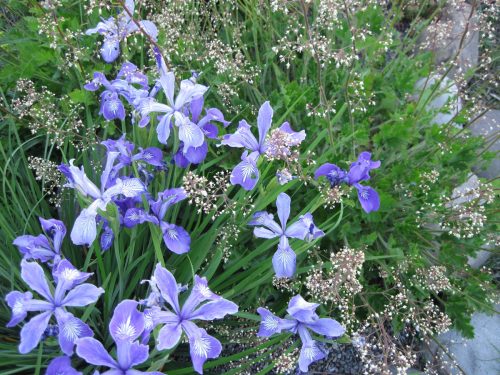
Significant rain in early October is a boon to gardeners who value the fall gardening season. This goes in spades for those of us who don’t irrigate heavily in summer. Some years we can be well into winter before the soil is fully workable, and that’s frustrating because we count on a long rainy season to get new plants established.
What’s more, this is the best time to move or divide certain plants that are naturally adapted to dry conditions in summer: For example, a number of iris are excellent low-water perennials, and several of them put out new roots in fall.
The first place to look for drought-tolerant iris is our own backyard, so to speak. The Pacific Northwest’s native iris are made for dry summers. Our own Oregon iris (Iris tenax) loves sunny banks and meadows and is abundant along rural highways.
Here in the Willamette Valley, its April flowers are usually blue-purple or lavender, but color varies, especially in the foothills and the Rogue Valley. The narrow, grassy foliage disappears in winter. This species re-seeds very freely. Years ago, I acquired my first Oregon iris by digging seedlings in fall from a construction site in the South Hills.
Near the coast, from Coos County south, Douglas iris (Iris douglasiana) is the dominant iris species. It is evergreen and vigorous. Flowers can be cream, lavender or purple. Douglas iris is one parent of a swarm of hybrids, collectively known as Pacific Coast hybrids, derived from Oregon and Northern California species.
Both Oregon iris and Douglas iris are great plants for native gardens, but the real glamor is found among those hybrids. Compact clumps of narrow evergreen leaves produce huge numbers of flowers with broad, often ruffled petals in an amazing range of colors and color combinations. And although they need little or no water in summer, they will usually tolerate average irrigation.
October is a great time to divide Pacific iris, provided they have started to produce new roots. Before you disturb an entire clump, dig around the perimeter and detach one or two fans of leaves. They should have fresh white roots attached, an inch long or more. In dry gardens, it’s a good idea to give clumps a good soak in September to encourage early root development. If you are planting divisions in pots, they’ll benefit from some protection. A cold frame or greenhouse is ideal. If you want to plant starts directly into the garden and miss the October window, it may be best to wait until soils begin to warm in February.
Several other types of iris are drought tolerant. The familiar bearded iris — dwarf, tall or intermediate, especially the older cultivars — can get by with little summer water. In fact, dry conditions may deter fungal diseases that tend to disfigure the leaves. (Bearded iris are usually divided in early summer, after the flowers fade.)
Less well-known is the pretty Japanese roof iris (Iris tectorum), which has flowers in lavender blue or white and tidy, light green leaves. Gladwyn iris (I. fetidissima) is extremely tolerant of dry soil, and while the flowers are fleeting and rather insignificant, the upright, evergreen foliage is a valuable addition in dry shade gardens, especially if you find the beautiful variegated form. Seedpods split in late summer, revealing bright orange-red “berries” within.
A few iris bloom in winter or very early spring. Algerian iris (Iris unguicularis) is fabulously fragrant but cold-tender and difficult. A Turkish species, I. lazica, though scentless, looks similar and is easy to grow. The delicate lavender flowers appear in February or March, nestled among tidy olive green foliage. Late summer to fall is the best time to divide these two, according to Kelly Dodson at Far Reaches Farm.
Lastly, there are many bulb-forming iris species that simply go dormant and vanish after bloom. My favorite is the very reliable and early-blooming Iris reticulata. Buy bulbs now, if you can find them, and plant them right away.
Some iris mentioned here can be hard to locate. Far Reaches Farm in Port Townsend, Washington, offers Iris lazica and some Pacific iris. A reliable source for Pacific Coast hybrids, as well as named selections of Oregon iris, is Xera Plants retail shop in Portland (no mail order). They are open Thursday-Sunday, 10 am to 5 pm, through Nov. 6, and should re-open “in early spring to mid-February, weather depending.” Check availability before you go: Greg Shepherd of Xera Plants tells me, “Our best selection of Pacific Coast iris will be from mid-March to late April.” The otherwise excellent website isn’t always up to date, but you can reach them at 503-236-8563.